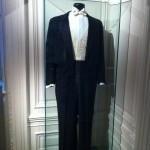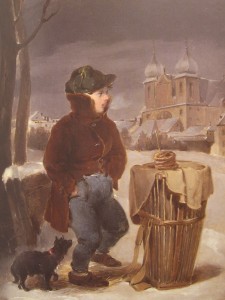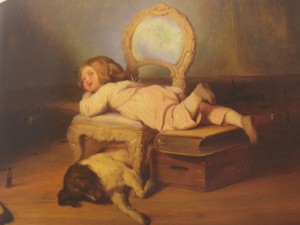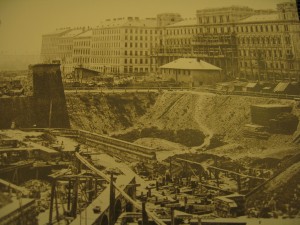After our visit to the opera and days of walking on the grand streets of Vienna, we were physically a little spent to say the least. But, aside from the tiredness, I noticed a lull in little Corzoo’s spirits.
“What seems to be the trouble, Corzoo? Are you feeling ein bißchen blau?”
“Maybe I’m feeling a little blue,” he said. The fact that he repeated the phrase in English and not German was a clue to me that he was indeed feeling blau. “I am not at all sure what is wrong,” he continued. “I have seen so many beautiful and extraordinary things here. I should be absolutely overjoyed. I mean, I AM so happy to be seeing all these things, but…” he trailed off, seeming sadder than ever.
I had a pretty good idea of just what might be ailing him.
This type of thing is common among travelers who are artistic and absorbent, but who have limited time. I have a friend who calls it “beauty fatigue.” There is simply only so much one can take in. When “beauty fatigue” occurs, the thing that can come next is feeling disconnected from every extraordinary thing you see. Suddenly nothing makes sense.
I made a plan for Corzoo since he did not seem to have the energy to come up with his own solution.
Step one: take a rest and slow down.
Step two: the next couple meals must be small, ordinary, and familiar if possible.
Step three: go to the hotel gym and get in a good exercise session.
Step four: when you go out again, look for the ordinary behind the extraordinary!
Corzoo agreed to try my tactics.
The following morning and early afternoon was spent moving slowly, going to the gym, eating simple meals. Aaaahhhhh!!!!
“Und jetzt? Wie geht’s, Corzoo?” my husband asked Corzoo before he took off with the orchestra.
“Shall I translate that for you?” he asked me. This is when I knew he was feeling better.
“Please, do! I cannot keep up with you two.”
He proceeded to translate with his usual glee. “Herr Bilger said, ‘and now? How are you feeling?’”
Corzoo was definitely back to his normal self and ready to see more. I had a specific plan as to exactly what we were going to see though. We would see nothing too grand – something that showed us the very ordinary processes behind the extraordinary.
 After Dave left for his rehearsal and concert, we ventured out to two places very close to our hotel. The first one was the Haus der Musik. We decided to focus on just one floor – the part that was the museum for the Vienna Philharmonic. We found three displays of very ordinary objects that especially delighted us: Mahler’s hat, items belonging to Brahms (glasses, pen, and calling card), and Leonard Bernstein’s tux!
After Dave left for his rehearsal and concert, we ventured out to two places very close to our hotel. The first one was the Haus der Musik. We decided to focus on just one floor – the part that was the museum for the Vienna Philharmonic. We found three displays of very ordinary objects that especially delighted us: Mahler’s hat, items belonging to Brahms (glasses, pen, and calling card), and Leonard Bernstein’s tux!
The next place we went was the Vienna Museum. It is a museum that goes through the history of the city, showing how and why it developed the way it did. There are several large models of the city at various points throughout time so we could see how Vienna developed and what forces shaped it.
We started in Roman times when Vienna was still known as Vindobona – the time of the Roman ruins that we had been in awe of a few days earlier in Michaelsplatz. We then moved through Early History and into the Middle Ages and into the more familiar Modern Period, all the while, marveling at what changed about the city and what stayed the same.
Corzoo delighted in ancient coins and old shop signs made out of iron and wood, and a very large “speaking trumpet” used from the tower of St. Stephen’s during the Siege of 1683 by the Ottomans. The church steeple would have been the highest point, so the watchman could call out warnings to the city from the top.
“It looks like the biggest megaphone I’ve ever seen!” said Corzoo. Also from this period, we saw brutal weapons and…
“Politics on playing cards!” Corzoo cried.
He was right. We had in front of us a deck of playing cards from the 1600’s. The suits were leaves, grapes, pomegranates, and hearts. And can you guess who the King of Hearts was? Yes, the leader of the Holy Roman Empire, of which Vienna was currently the capital – Leopold I.
We also saw collections of paintings of ordinary scenes from the city in the 1800’s: a postman, a girl selling honey and fruit, a copper engraver, an ink vendor.
 We saw a painting of a cold, poor boy selling pretzels on the street, accompanied by his dog. The placard beside the painting explained that there were many poor and vulnerable children alone in Vienna at that time, and there was a movement of painting whose goal was to bring to them and other social issues to the public eye.
We saw a painting of a cold, poor boy selling pretzels on the street, accompanied by his dog. The placard beside the painting explained that there were many poor and vulnerable children alone in Vienna at that time, and there was a movement of painting whose goal was to bring to them and other social issues to the public eye.
We saw a painting of a quite better off boy, also with his dog, but in his own world. The adults around him were small and like statues, without life or motion.
 “Corzoo, is that how you see us adults? No spunk whatsoever?”
“Corzoo, is that how you see us adults? No spunk whatsoever?”
“I plead the fifth,” he said. Then, “shall I define what I mean by pleading the fifth?”
“No, Corzoo, thank you very much. I understand that you would rather say nothing than to put yourself in a less-than-generous light.”
We then approached one of the huge models of the city of Vienna that were on display throughout the museum. This one was from the era JUST before the Ringstrasse was built.
“Shall I tell you about the building of the Ringstrasse?” asked Corzoo.
“That, my young friend, you may explain to me,” I said.
“It is quite interesting because it all has to do with the old city walls. Do you see this flat ring of land that goes all the way around the city?”
I nodded as we walked around the large model. It looked like a planned park to me with little pathways crisscrossing it.
“Well, that is what is known as a glacis. By the 1800’s it had turned more into a park, but before that, it was the last area before the city walls. It was cleared so that those in the city could see who was approaching or attacking and get them, because they’d have no place to hide in that cleared bit of land!”
“Indeed!” I exclaimed. “Go on…”
“Well, Emperor Franz Joseph – the one who ended up having his own tea room in the Staatsoper, remember,” he teased, “declared that he wanted those old city walls and moats to come down, for the suburbs to be incorporated into the city, and for the glacis to be turned into a beautiful grand street!”
“Aha!” I said. “And that is why all of those buildings have the same feel to them.”
“You mean to say homogenous?”
“Yes, yes, Corzoo. My goodness, you know big words for your age! Yes, you could say homogenous. Not exactly the same, of course, but all of the same grand spirit.”
We walked around the enormous model looking for buildings in the Innere Stadt, or Center City, that we could recognize and the streets we had walked on during the past few days. As we approached the southern part of what would be the Ringstrasse, on the railing were explanations and old photographs of what would be the first building to be built on the Ringstrasse – none other than the Wiener Staatsoper!
 “Look at this photo, Corzoo!”
“Look at this photo, Corzoo!”
It was the foundations being dug for the opera house. So large was the hole in the ground that the people working inside the hole looked like bugs.
“Every grand building must start somewhere, and the grander the building, the larger the foundation!”
We marveled at the undertaking for a while.
We then noticed a small placard explaining about the architects Eduard van der Null and August Sicard Sicardsburg. It said there that public response to the building was very negative and spoken about in very derogatory ways in the press. Eduard van der Null was so distressed that he killed himself. Later, his architectural partner Sicardsburg died – the placard said he died of a broken heart. Other sources say he died of a heart attack or tuberculosis. In any case, neither architect lived to see opening night.
“How is it possible?” cried Corzoo. “If he only could have seen the future. If he only could have seen that there were tours in five different languages each hour yesterday – just to see his beautiful building.”
It was truly an awful and very sad thing to contemplate. The whole situation seemed unthinkable. We stood by the railing and looked at the picture of the foundations for a while.
Then Corzoo said, “I think what this means is that we must never despair, no matter what people say.”
“I believe you have something there, Corzoo. All we can ever do is give the best of ourselves. What others say and think means nothing in the grand scheme of things. What is seemingly a failure right now may lead you somewhere else important, or may turn into something you could never imagine.”
Though our visit to the museum came to an end on this melancholy note, we had learned so much about what made this city tick, and that, indeed, in every era of the city, there were little boys like Corzoo, and grown women like me. They had tea pots, they had chocolate servers, store signs, calling cards, eye glasses, and hats. They had ways of communicating – maybe not by computer or text, but they had their ways – sometimes by trumpet! They had playing cards and political cartoons. Boys sold pretzels on the street and played with their dogs.
“Do you feel like you have gotten to know Vienna a little bit, Corzoo? What do you think?”
“Wien ist wundershön!”
“Vienna is indeed wonderful,” I replied.
“…and it is also complicated in all the ways people can be complicated,” he added. “But there is so much left to get to know next time – so much more to see. I can’t wait!”
Auf Wiedersehen, Wien! Till we meet again.
